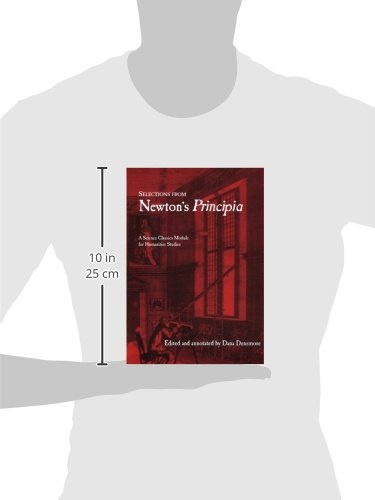


Selections from Newton's Principia
I**V
Just enough Newton and just enough explanation to be usable ...
Just enough Newton and just enough explanation to be usable in an undergrad classroom, which is where I'm using it.
N**R
Three Stars
Fair
V**O
Readable Newton
These selections from the Principia may be divided into three groups: the text-only sections (definitions, rules of philosophising, general scholium), sampling of non-mathematical theory (evidence that planets move around the sun), sampling of the mathematical theory (beginnings of the inverse square law, the "moon test"). The last of these is the most substantial and interesting. First we look at Newton's wonderful proof of Kepler's law of equal areas (book 1, prop. 1), which follows very easily from the idea of dividing the orbit into infinitesimally thin triangles.Next we use this same idea to prove that if a planet moves uniformly in a circle then the centripetal force is proportional to the arc squared over radii (book 1, prop. 4). We will prove it in the case of infinitely small time intervals; the general case follows easily. Suppose the planet moves from A to B along a circle with center S in an infinitely small interval of time. Draw the diagonal through A and call the opposite point D. Draw the perpendicular to ASD through B, cutting ASD in C. If there were no gravity the planet would have moved along the tangent to the circle to some point E instead of to B (BE is parallel to ASD because the time interval is infinitely small). Now ABC is similar to ABD so AC/AB=AB/AD, i.e. BE=AC=AB^2/AD=arc^2/diameter. Since BE measures acceleration (change in velocity vector), the theorem follows. Substituting Kepler's harmonic law (radii squared are proportional to orbital periods cubed) into this proposition shows that the forces are inversely proportional to radii squared (corollary 6). But there's more. Corollary 9 will be crucial for the "moon test". It compares the motion along the arc with the corresponding free fall motion: (diameter)/(arc)=(arc)/(distance fallen). The relation AC/AB=AB/AD from the above proof says precisely this in the case of infinitesimal time, because C is the free fall position corresponding to B (C is the end point when the same acceleration BE works on the planet at rest). Thus we have (diameter)/(small arc)=(small arc)/(small fall), and for a non-infinitesimal time we still have arc^2 proportional to time, which gives (big fall)/(small fall)=(big arc)^2/(small arc)^2. Multiplying these two identities and rearranging proves the corollary.Now for the moon test (book III, proposition 4). We just proved that (diameter)/(arc)=(arc)/(distance fallen). We know the diameter of the moon's orbit and the arc it covers in, say, one minute. Therefore we know the distance it would fall in one minute "if the moon be supposed to be deprived of all motion and dropped, so as to descend towards the earth". But above we saw that gravity is inversely proportional to the inverse square of distance, and the moon is 60 earth radii away, so now we know the distance the moon would fall if it was dropped close the surface of the earth (60^2 times greater). Of course we already know how far regular objects fall in one minute under the influence of regular gravity (determining this means determining g, which is best done using pendulums; Newton refers to Huygens). These two distances come out almost exactly the same, "and consequently, that force by which the moon is held back in its orbit, will be that very force which we usually call 'gravity.'"
Trustpilot
1 month ago
3 days ago